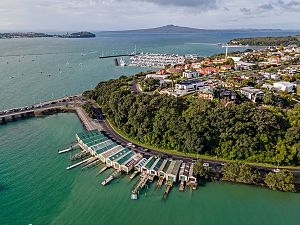Ōrākei facts for kids
Quick facts for kids Ōrākei |
|
|---|---|

View from Hobson Bay looking northeast over Orakei towards Rangitoto Island
|
|
| Basic information | |
| Local authority | Auckland Council |
| Electoral ward | Ōrākei |
| Local board | Ōrākei |
| Population | 5625 (2018) |
| Facilities | |
| Train station(s) | Orakei Train Station |
| Surrounds | |
| North | (Hauraki Gulf) |
| Northeast | Mission Bay |
| East | Mission Bay |
| Southeast | Kohimarama, Meadowbank |
| South | Remuera |
| Southwest | Remuera |
| West | Parnell |
| Northwest | (Waitematā Harbour) |
Ōrākei is a suburb of Auckland city, in the North Island of New Zealand. It is located on a peninsula five kilometres to the east of the city centre, on the shore of the Waitematā Harbour, which lies to the north, and Hobson Bay and Orakei Basin, two arms of the Waitematā, which lie to the west and south. To the east is the suburb of Mission Bay. The mouth of the Waitematā is to the immediate north of Ōrākei, lying between Bastion Point, in Ōrākei, and North Head, in Devonport on the North Shore.
Overview
The New Zealand Ministry for Culture and Heritage gives a translation of "place of adornment" for Ōrākei.
Ōrākei is home to some of Auckland's most expensive real estate. House prices on Paritai Drive street start at $3m and range to $12m. The local secondary school is Selwyn College.
Bastion Point is the location of the Savage Memorial, the tomb and memorial garden for Michael Joseph Savage, the first Labour Party prime minister of New Zealand and one of the country's most popular prime ministers, who died in office in 1940. This magnificent Art Deco ensemble by Tibor Donner and Anthony Bartlett was officially opened in March 1943 and affords remarkable views of the Waitemata Harbour.
History
Ōrākei was the first location where the New Zealand Flying School operated from between October and November 1915, before moving to Mission Bay, and a permanent location at Kohimarama in 1916.
In 1936-37 John A. Lee proposed to evict the 120 Māori living in the foreshore pa at Bastion Point and to include the land in the proposed Ōrākei state housing scheme; the proposal (seen as using Māori land as a park for white children) attracted many local objections (including Robin Hyde in No More Dancing at Orakei) and was reversed by Prime Minister Savage on his return from overseas.
Again, the suburb achieved national attention in 1977 when Māori protestors occupied vacant land at Bastion Point, which had formerly belonged to the Ngāti Whātua Ōrākei iwi but had been acquired cheaply for public works (defence) in the 1880s. Members of the tribe occupied the land and demanded its return. The land was largely returned to the iwi after a long and not entirely bloodless occupation.
Demographics
| Historical population | ||
|---|---|---|
| Year | Pop. | ±% p.a. |
| 2006 | 5,352 | — |
| 2013 | 5,475 | +0.33% |
| 2018 | 5,625 | +0.54% |
Ōrākei, comprising the statistical areas of Ōrākei West and Ōrākei East, had a population of 5,625 at the 2018 New Zealand census, an increase of 150 people (2.7%) since the 2013 census, and an increase of 273 people (5.1%) since the 2006 census. There were 2,073 households. There were 2,676 males and 2,946 females, giving a sex ratio of 0.91 males per female, with 909 people (16.2%) aged under 15 years, 1,089 (19.4%) aged 15 to 29, 2,673 (47.5%) aged 30 to 64, and 954 (17.0%) aged 65 or older.
Ethnicities were 70.3% European/Pākehā, 18.8% Māori, 6.9% Pacific peoples, 13.9% Asian, and 3.6% other ethnicities (totals add to more than 100% since people could identify with multiple ethnicities).
The proportion of people born overseas was 30.4%, compared with 27.1% nationally.
Although some people objected to giving their religion, 45.9% had no religion, 37.8% were Christian, and 10.4% had other religions.
Of those at least 15 years old, 1,890 (40.1%) people had a bachelor or higher degree, and 450 (9.5%) people had no formal qualifications. The employment status of those at least 15 was that 2,394 (50.8%) people were employed full-time, 663 (14.1%) were part-time, and 189 (4.0%) were unemployed.
Education
Ōrākei School is a full primary school (years 1–8) with a roll of 345.
St Joseph's School is a state-integrated Catholic full primary school (years 1–8) with a roll of 46.
Both schools are coeducational. Rolls are as of April 2023.
Marae
Ōrākei Marae and its Tumutumuwhenua meeting house is a traditional tribal meeting ground for the iwi of Ngāti Whātua and Ngāti Whātua Ōrākei, and their hapū of Ngā Oho, Te Taoū and Te Uri. In the 1940s, the Ōrākei Pa was one of the last places where traditional pre-European kūmara cultivars (either hutihuti or rekamaroa) were grown.
See also
- Orakei Train Station
Images for kids
-
The Michael Joseph Savage Memorial



